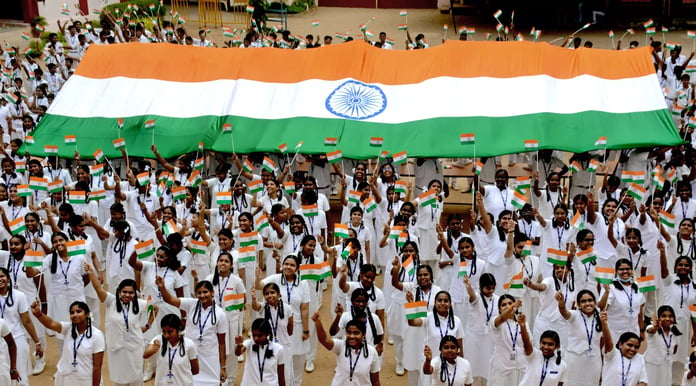New Delhi, India (TEH) – The echoes of the past resonate with a profound sense of pride and reverence as India commemorates its Independence Day. A day marked by the culmination of relentless struggles, sacrifices, and an indomitable spirit that led to the birth of a sovereign nation.
By the late 17th century, European traders had established outposts on the Indian subcontinent. The East India Company, with its superior military prowess, fought and conquered local kingdoms, becoming the dominant force by the 18th century. The Government of India Act of 1858 allowed the British Crown to take full control of India after the Indian Rebellion of 1857.
Civic society gradually began to grow in India in the ensuing decades, most notably the Indian National Congress Party, which was founded in 1885. The years following World War I saw the passage of the unpopular Rowlatt Act and demands for Indian self-rule, as well as colonial reforms like the Montagu-Chelmsford Reforms. The period’s unrest culminated in a number of national non-violent movements.
The British gradually passed the reform into law in the 1930s, and Congress won the ensuing elections. The next ten years saw a lot of political unrest due to the All-India Muslim League’s Muslim nationalism rising, Indian involvement in World War II, and the Congress’ final drive for non-cooperation. The 1947 declaration of independence put an end to the rising political turmoil. The deadly division of colonial India into India and Pakistan dampened the celebration.
Independence Day of India: Significance
The partition of British India into the Dominions of India and Pakistan, accompanied by bloody riots, widespread deaths, and the eviction of almost 15 million people owing to religious violence, occurred concurrently with India’s declaration of independence. Jawaharlal Nehru, India’s first prime minister, raised the country’s flag over the Lahori Gate of the Red Fort in Delhi on August 15, 1947. The current Prime Minister raises the flag and addresses the country on each successive Independence Day.
The national broadcaster of India, Doordarshan, broadcasts the entire event, which typically kicks off with some of Ustad Bismillah Khan’s shehnai music. India celebrates Independence Day with flag-raising ceremonies, parades, and cultural events.
Who designed the Indian national flag?
Surayya Tyabji
Surayya Tyabji, a prominent artist and the wife of an Indian civil servant, Badruddin Tyabji, has been credited by some historians and family members with the design of the Indian National Flag. According to these accounts, Tyabji was approached by Jawaharlal Nehru to design a flag that would represent the entire nation.

Tyabji’s design, as per these narratives, was chosen for its simplicity and symbolic representation of India’s diverse culture. The saffron, white, and green bands, along with the Ashoka Chakra, were said to be her creation. Some even claim that Tyabji’s design was officially adopted on July 22, 1947.
On the other hand, Pingali Venkayya, a freedom fighter and an ardent follower of Mahatma Gandhi, has been widely recognized as the designer of the Indian National Flag. Venkayya’s association with the flag dates back to 1921 when he met Gandhi and presented him with a design.
Pingali Venkayya

Venkayya’s initial design underwent several modifications, and the final version was adopted as the national flag. His contributions have been acknowledged by various governmental bodies, and he has been honored with postage stamps bearing his image.
All you need to know about Independence Day of India
- The Indian tricolor was designed by Hyderabadi woman Suraiyya Tyabji, a prominent artist and the wife of an Indian civil servant, Badruddin Tyabji. But, officially Pingali Venkayya is known as the designer of Indian national flag, a freedom fighter and a follower of Mahatma Gandhi.
- The only materials used to create the national flag are hand-spun and hand-woven cotton khadi bunting.
- The top band, which is saffron in color, symbolizes the nation’s fortitude and valor; the middle band, which is white and features a Dharma Chakra; and the bottom band, which is green, depicts the nation’s fertility, growth, and good fortune.
- Indians did not have a recognized national song at the time of independence. Rabindranath Tagore wrote the song Bharoto Bhagyo Bidhata in 1911; it was renamed “Jan Gan Man” and declared the national anthem of India by the Constituent Assembly on January 24, 1950.
- On Independence Day, Indian Prime ministers delivered their speeches from behind a bulletproof glass panel since Indira Gandhi’s murder. However, ever since Narendra Modi was elected the prime minister in 2014, he has abandoned this custom. Therefore, more drastic steps were taken to assure security.


